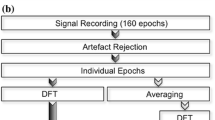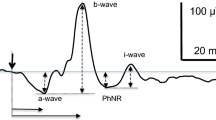Summary
Problems inherent in the use of selective amplification of the flicker ERG (e.g., the influence of the waveform of the response) are discussed.
The critical frequency of flicker fusion (CFF) and the course of the Intensity / CFF curves depend completely on the procedure used for improving the signal-to-noise-ratio.
The computer of average transients (CAT) is superior to all other procedures meant for this improvement, although a less expensive and easy to handle procedure as selective amplification is quite suitable in the majority of cases in clinical practice.
Résumé
Les problèmes incorporés dans l'usage d'un amplificateur sélectif concernant l'influence de la forme de l'onde sont discutés.
La fréquence critique de fusion (FCF) estimée, et aussi l'évolution de la courbe Intensité / FCF, dépendent du procédé utilisé dans l'amélioration du rapport signal/bruit. Le calculateur des moyennes transitoires (CAT computer) est de beaucoup supérieur aux autres procédés correspondants, mais pour des applications cliniques l'amplificateur sélectif du flicker ERG est suffisant comme instrument peu coûteux, sûr, et facile à utiliser.
Zusammenfassung
Fragen in Bezug auf selektive Verstärkung des Flimmer ERGs, wie z.B. der Einfluss der Wellenform, werden diskutiert.
Die Bestimmung der Flimmerfusionsfrequenz (FFF) und die Intensität/ FFF Kurven hängen völlig ab von dem Verfahren, das benutzt wurde zur Vergrösserung des Störpegelabstandes.
Der Komputer ist allen anderen Verfahren überlegen, wenn es sich um diese Verbesserung handelt; für viele Zwecke in der klinischen Praxis genügen aber weniger kostspielige und einfachere Verfahren, wie selektive Verstärkung des Flimmer-ERGs.
Similar content being viewed by others
References
Bornschein, H. & Lahoda, R. (1960) Harmonic Analysis of the Human Flicker Electroretinogram. Proc. III Int. Conf. Med. Electron., 342–344.
Granda, A. M. (1961) Electrical Responses of the Human Eye to Colored Flickering Light. J. opt. Soc. Amer., 51, 648–654.
Granit, R. & Wirth, A. (1953) Scotopic “Blueshift” Obtained by Electrical Measurement of Flicker Resonants. J. Physiol. London, 122, 386–398.
Granit, R. (1958) Physiological Basis of Flicker Electroretinography as Applied in Clinical Work. Ophthalmologica 135, 327–248.
Henkes, H. E. & van der Tweel, L. H. (1964) Amplification sélective du Flicker-ERG - Avantages et Limites. Ann. thér. clin. en Ophtal. (to be published).
— & —, & Denier van derGon, J. J. (1956) Selective Amplification of the ERG. Ophthalmologica 132, 140–150.
Author information
Authors and Affiliations
Additional information
Eye Clinic, Rotterdam Medical School and Laboratory for Medical Physics, Amsterdam University.
Rights and permissions
About this article
Cite this article
Henkes, H.E., van der Tweel, L.H. Implications of selective amplification of the flicker-electroretinogram. Doc Ophthalmol 18, 447–451 (1964). https://doi.org/10.1007/BF00160596
Issue Date:
DOI: https://doi.org/10.1007/BF00160596




